Patent & Trademark Process
Establishing a legal foundation for your ideas and company is the backbone of any successful business. At Gearhart, we take great pride in helping clients achieve their goals and being a building block in their success.
The Patent Process
In patent law, there are three main parts to patenting an invention. First, a global or U.S. patent search is conducted over many proprietary databases to make sure your invention is original. Second, a detailed patent application is drafted and filed with the patent office to establish that your concept is unique. The application must take into account not only the invention, but also the legal landscape, prior patent submissions and the inventor’s commercialization plans. The final step is to prosecute the patent with the USPTO until it’s approved. The entire process takes years to finalize, so it’s important you work with someone experienced in patent services and people you trust who will be committed over the long-term.
Often our clients file a provisional patent application to start. That holds the filing date for them while they refine their product and test the market. Filing a patent application allows the inventor to move forward with the commercialization of their product. One year from the date of filing a provisional patent application, the inventor must file a utility patent application based on the provisional if they want to go forward. The utility patent application includes the disclosure of the provisional patent application and any changes that the inventor has made to the invention since the provisional application filing. The utility patent application is published and examined by the USPTO patent examiner.
We’ll help you maximize your chances of success with the U.S. Patent & Trademark Office (USPTO) and minimize prior art issues with competitors by understanding prior patent submissions in your field, the overall review process and how to draft the proper point of view in the application.
The USPTO does not grant a patent just because the paperwork has been filed; we must argue the points of the patent with the patent examiner and convince him or her that the invention meets all of the USPTO’s requirements.
Your chances of success in this step are increased if you use an experienced patent attorney who has dealt with the USPTO on patent inventions and is familiar with their requirements. Time and time again, Gearhart Law has consistently helped our clients achieve success.
If a competitor infringes your patent, we can take steps to help you prevent further patent infringement. We work to minimize your cost of preventing the patent infringement and settle out of court. You may be able to collect damages from the patent infringement.
Our experience spans patent application drafting, domestic and international patent prosecution, due diligence, opinion rendering for patent infringement and validity, agreement and transactional work, expert testimony and litigation support.
Are you ready to patent an idea? How long does it take to get a patent? The patent application timeline shows the steps and timing of applying for a patent:
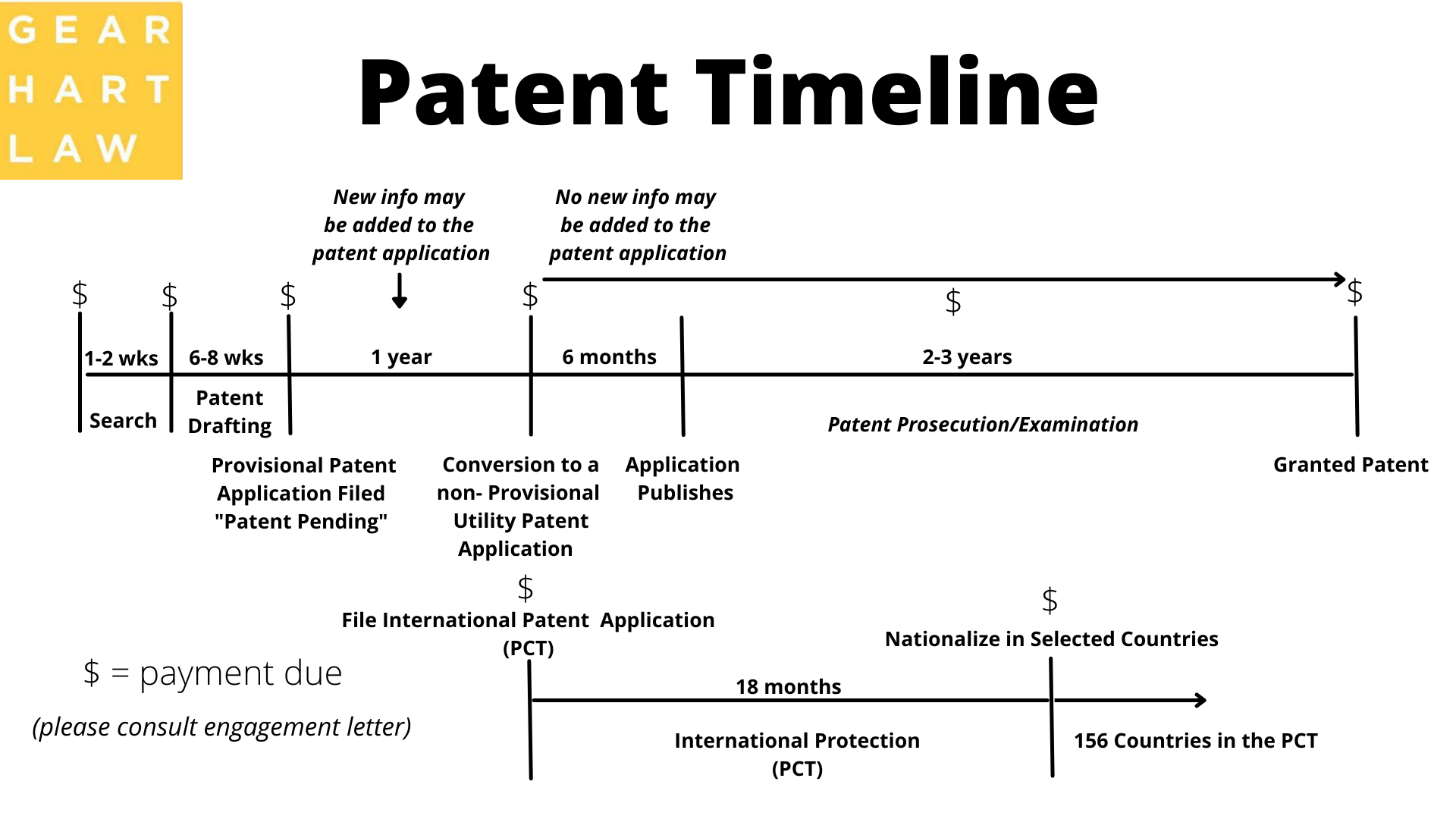
Search
The process usually starts with a search to determine that there isn’t already a patent ,patent application, or public disclosures for the invention, which is called “prior art.” It also identifies patents for inventions that are similar to your invention.
If there’s one that’s too close, an inventor has two options: either start over with a new invention or modify their invention, i.e.: design around the prior art. If the person conducting the search determines that there’s a good chance that the patent will be allowed, the search also allows them to make arguments in the application about why this invention is different from similar inventions.
Patent Drafting
After a successful search, the patent application is drafted.
This involves drafting claims, which are done a certain way and bear no resemblance to normal language. The claims are important because that’s what the patent examiner studies when deciding whether or not to allow a patent. The specification is drafted too, and that’s much more understandable. It describes the invention in excruciating detail but in normal language and uses drawings or figures for illustrative purposes. Usually, there’s some back and forth between the person drafting the application and the inventor to make sure everything is correct. When can you say your invention is patent pending? As soon as the application is filed with the USPTO, the invention is patent pending.
Provisional v. Non-Provisional or Utility Patent
If the invention is in the process of being developed, we recommend the inventor file a provisional application. This gives them a year to work on the project before finalizing their application as a utility application in the USPTO. The provisional is a full-blown application and is nearly complete; there may be a few changes or additions to convert it to a utility application but we try to capture the complete essence of the invention in the provisional application. The reason for this is that the date an application is filed with the USPTO, or the ‘filing date’ determines who receives the legal rights if two competing applications are filed. The better defined your invention is, the stronger your case is. The USPTO counts the date of the provisional filing as the filing date.
Application Publishes
The USPTO holds the patent application in secret about 18 months from the provisional filing. Then the application is published and anyone can read it.
Patent Prosecution
At this point, the patent examiner scrutinizes the application and compares it to issued patents and applications in the USPTO database and around the world; this starts ‘prosecution’ where the patent attorney argues for their client.
The examiner usually finds reasons NOT to allow the patent application to mature into an actual patent. But attorneys love to argue, so a skilled patent professional presents arguments to the examiner as to why the patent should be allowed. This process usually occurs over 2-3 years.
Granted Patent
At this point, the USPTO has been convinced that the invention is novel or non-obvious and deserves to be patented. The patent is granted and the patent owner is entitled to a limited monopoly on their invention for 20 years from the first utility filing date.
International patent protection
File a PCT (Patent Cooperation Treaty) application.
If an inventor or entrepreneur wants to protect their invention in other countries, then they file a PCT Application.
The PCT is a treaty among more than 150 nations that allows inventors international benefits. The PCT Application is filed within 12 months of the first filing date of a patent application in the U.S. The PCT Application is a placeholder; it gives the inventor 18 months from the date of filing of the PCT to decide which countries they want to obtain a patent in, then they file in those countries, or ‘nationalize’ in those countries. The examination process starts over in each country.
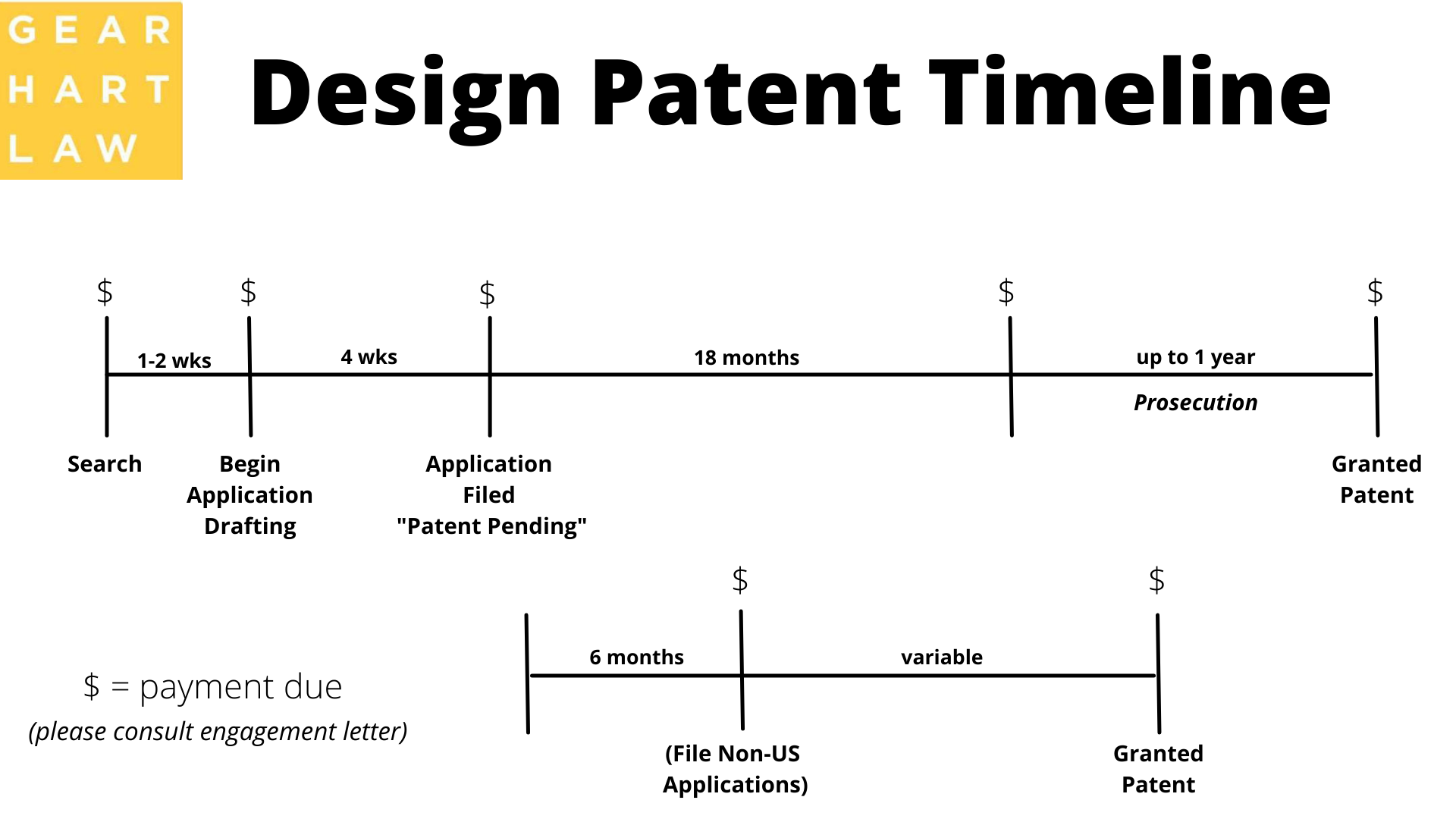
Many of the steps are the same for a design patent as for a utility patent, but with shorter time frames. Design patent protection only lasts 15 years from the issue date as opposed to 20 years for the utility patent. Additionally, design patents don’t have a provisional option but design patent applications are not as often initially rejected by the USPTO as are utility applications.
Non-US filings for design patents
An inventor has 6 months from the application filing to decide which countries to file in and once filed, the process in most countries will be similar to that of the US, with each country having its own procedures.
Trademarks

Your brand is your product and service name. We will fight to protect your point of difference. A trademark is an affordable way to get protection for the name of your product or service, and our trademark services help to make that an easier process, both in the US and around the world.
We work with attorneys and law firms around the globe to facilitate the filing of our clients’ trademarks, and to help foreign attorneys file their clients trademarks in the US.
Once you have a registered federal trademark you can use the symbol ® in connection with your mark in the US. Having a trademark helps your customers to recognize your product or service over that of your competitors.
To get started you don’t need to have the name in use yet—according to trademark law, a trademark can be filed as an intent-to-use mark. You merely need to have good faith intent to begin using the mark. Once you are ready to use the name in commerce, we can help you secure the federal registration you need. We can assist you from the first step of choosing your brand, searching the registered trademark database to make sure your desired trademark is available, through the category research and registration procedure. We can also facilitate the filing of your trademark in foreign countries through our associates in those countries, and we can continue to provide assistance in maintaining the mark and monitor possible trademark infringements and advise you if any actions are needed.
You can register for a U.S. trademark through the USPTO (United States Patent and Trademark Office) and in other countries through their trademark offices. We help our clients register their trademarks wherever they want to conduct business and protect their brand. You can protect your brand around the globe.
Whether you’re operating in New Jersey, New York, or Philadelphia, or anywhere else around the world, a trademark is a great way to add value to your business. Let Gearhart Law provide you with the comprehensive service you deserve.
How long does it take to get a trademark? The trademark timeline shows the steps and timing of applying for a trademark:
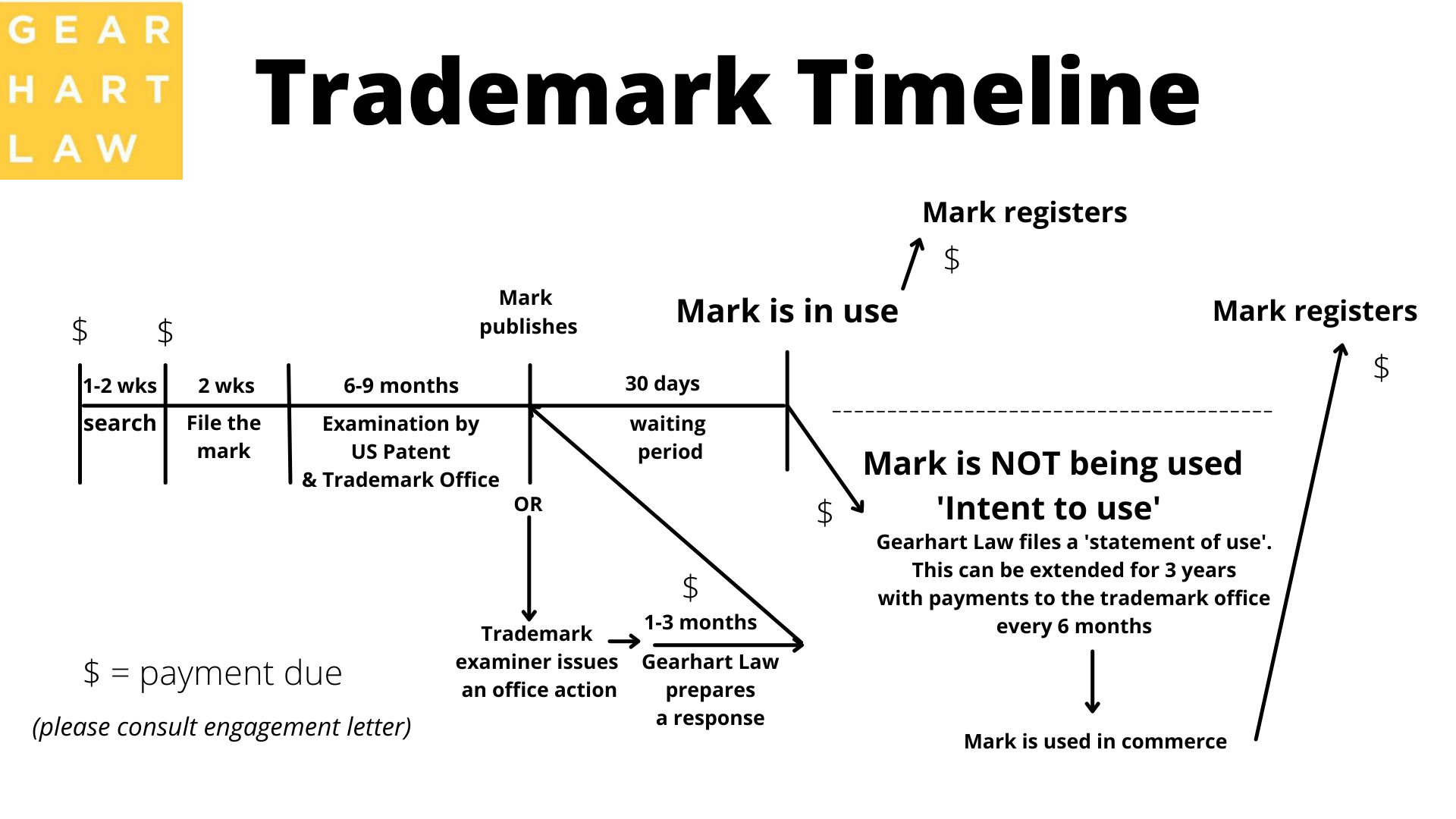
Search
We strongly suggest that you have a trademark search done before you invest heavily in marketing for your company. Even if the search results don’t show an exact match to the name you’ve chosen, there could be a ‘likelihood of confusion’ with a name that’s close. A skilled trademark attorney can help you navigate the USPTO on this and other issues.
File the Mark
Whether or not you’ve used your trademark, an application can be filed. If you’re using your trademark, i.e.: on your website, on social media etc., you can file a ‘mark in use’ application. To file an application, the USPTO requires a form to be submitted with information such as your contact information, what the mark is, and if your trademark is in use, a ‘specimen’ which is a picture of your trademark in use, for instance, a screenshot of it on the product and/or product packaging. Your mark can be a word or phrase, a logo, or a combination of both. Trademarks may also be colors, sounds, or scents. A trademark attorney can advise you on what’s best to file. You also need to designate the class of goods in which you plan to use the mark; for each class you plan to register your mark in, you have to pay a separate fee to the government.
Most people file federal trademarks as they’re selling across state lines. If you’re not selling across state lines, you can file for a state trademark.
Examination by US Patent & Trademark Office
After the USPTO receives your application, they do their own search to determine if there are other trademarks too close to your mark. If they don’t find anything, then your trademark publishes. If they do find something, then they issue an office action, basically a letter to you or your attorney stating that they found trademarks too close to your mark, so you can’t have your mark. This doesn’t mean you can’t have it; a skilled attorney may be able to devise an argument to convince the trademark examiner to register your mark.
Mark Publishes
Once your mark has been published, other people have 30 days to contest or ‘oppose’ the mark, although they can file an extension to prolong the 30 day window. This is relatively rare, but every trademark application has to wait 30 days.
Mark Registers
If the mark is in use, then it registers after the 30 day period and you can use the Ò symbol.
Mark is in ‘intent to use’ state
Until you use your mark in commerce, you have to pay to keep it alive in the USPTO. Once you use your mark in commerce, then it registers and you can use the registered trademark symbol.
Copyrights

A copyright protects literary works (including software code), musical, dramatic, choreographic, pictorial or graphic, audiovisual or architectural work, or a sound recording, from being reproduced without the permission of the copyright owner. Thanks to copyright law, this gives the author or current owner sole right to authorize copies or reproductions of the work and to create derivative works. All an author has to do is register the work to obtain their copyright registration certificate. The author(s) may transfer the copyright to any other party if they choose to do so, and this will need to be recorded with the U.S. Copyright Office. The right lasts for the rest of the author’s life, plus 70, 95 or 120 years, depending on the nature of authorship and creation date of the work. Sounds simple, right?
Copyright may appear easy to the layperson but can be challenging in practice. That’s why copyright services are so important. For instance, it is of the utmost importance that a legally enforceable agreement be used to transfer any one of the bundle of rights. Without it, ownership and title to the work may be in dispute and unlike the U.S. Patent and Trademark Office, which offers an internal administrative process for resolving most disputes, the arena for copyright disputes is the United States courts. At Gearhart Law, we work with you to ensure that your copyrighted works are not only protected but that any use, transfer or commissioning of a work is protected as well. We also guide creators and innovators in understanding the overlap between copyright and patent and trademark law and illuminate concepts such as fair use of copyrights so that you can better appreciate the line of where copyright infringement starts and ends. After all, if you create an original work of art, the least you can do is protect and profit from it over your lifetime.
Due Diligence
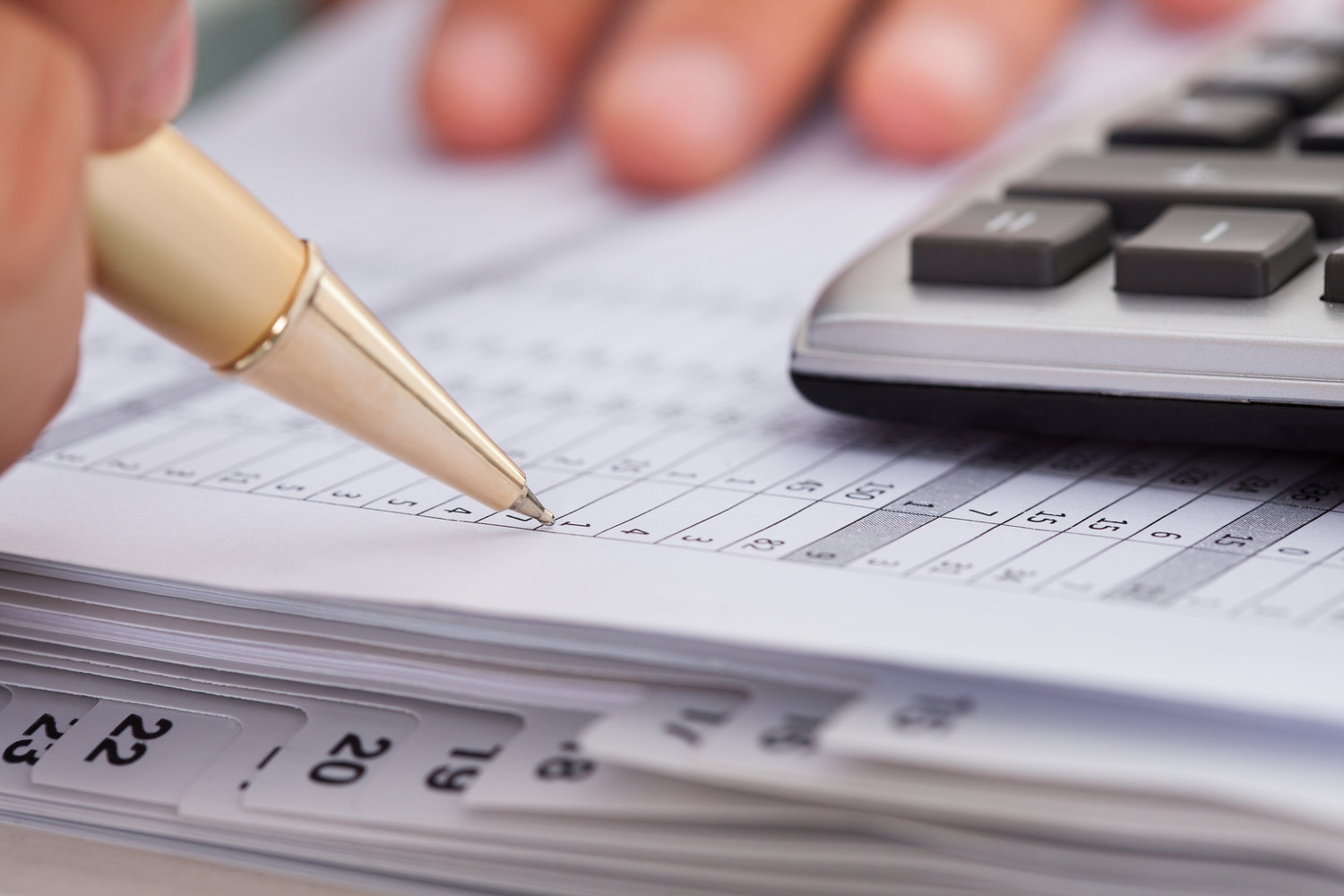
When companies buy or invest in other companies, they conduct due diligence, looking into the company’s records to make sure there are no legacy issues or financial misrepresentation and to ensure that intellectual property portfolios are of sufficient quality and properly protected.
If a patent won’t stand up in court, it’s worthless. For companies with high-value brands, buyers need to ensure that trademarks are valid and their ownership is correct. Companies seeking investment will also conduct legal audits to make sure they have the most complete IP portfolio possible.
Gearhart Law has been on both sides of the equation. From the small entity side, we’re happy to say that our patents, and in particular our biotech patents, have withstood scrutiny by law firms acting on behalf of investors during the due diligence process. From the investors’ side, we’ve discovered flaws in the IP portfolios of some of the firms they’re evaluating. When flaws are discovered, investors can then decide how to proceed, either by demanding the flaws be fixed, if possible, or by re-negotiating the terms of the investment.
Technology Agreements
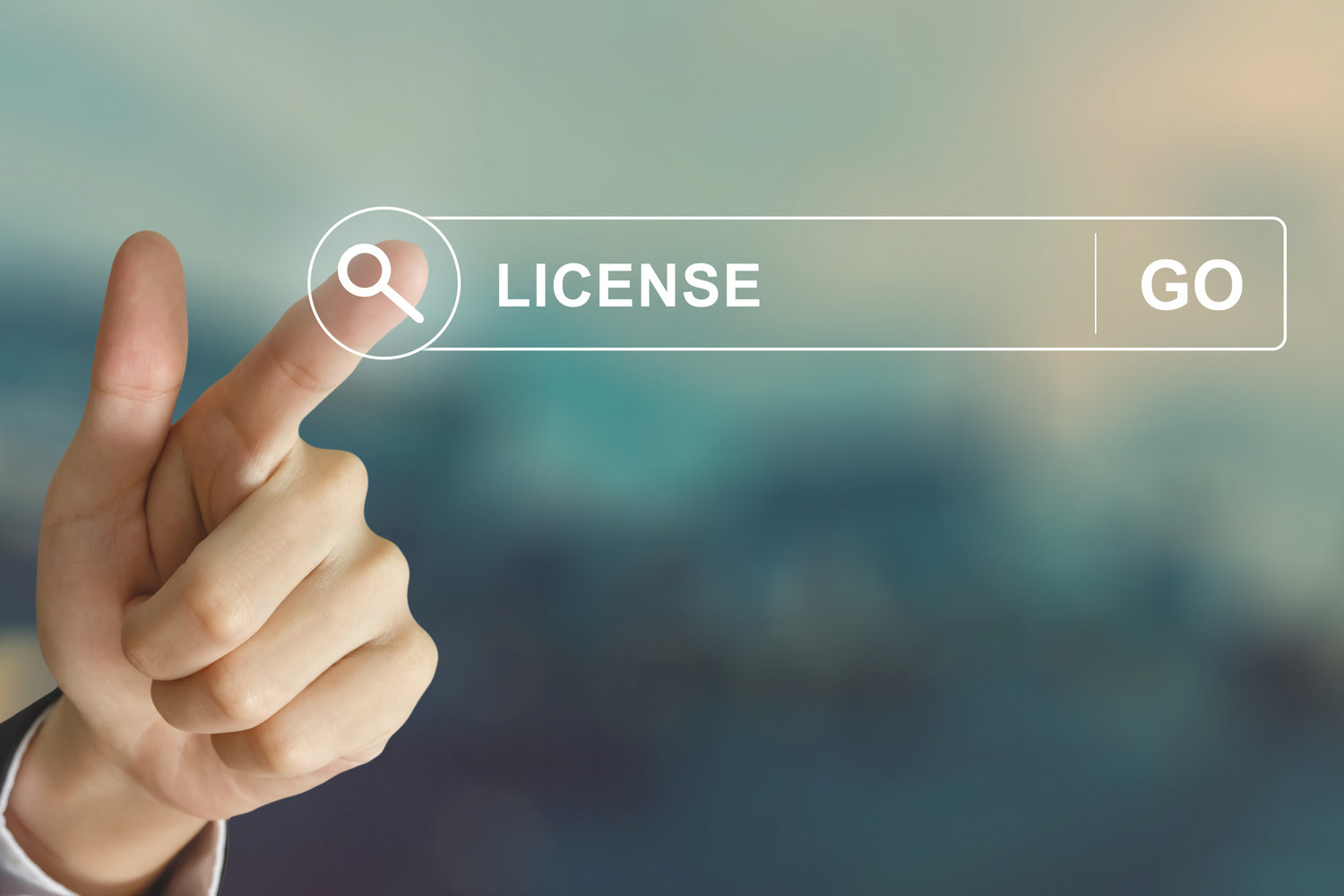
Once an inventor or business has filed for or obtained intellectual property protection, they are often left with the question of “what now?” For many, the “what now” equates to “how do I make money” from intellectual property. There are many options available to inventors and businesses alike to assist in commercializing intellectual property.
A non-disclosure agreement is an agreement between at least two parties that outlines confidential material and information that the parties wish to share with one another for certain purposes but wish to restrict access to or by third parties. A license is an agreement that enables the owner of intellectual property to make money from an invention or work by charging a fee, typically a royalty, for product use by a third party. An assignment is an agreement that transfers some portion of the ownership interests in intellectual property rights, traditionally in return for a monetary payment.
The above non-limiting examples illustrate the vast differences in the agreements that abound in the intellectual property field. Gearhart Law has the experience and expertise to not only draft such agreements, but to review and red-line agreements received by our clients from third parties to best ensure our clients’ needs come first.
Trade Secrets

More and more, information assets are what define a company’s competitive value.
Relying on patents, copyrights and trademarks to safeguard their positions in the marketplace is key, but those protections have limits. In many fast-moving markets, businesses have come to rely more on confidentiality to protect the value of their innovations. These are known as “trade secrets” and encompass confidential business information, product designs, manufacturing techniques and strategic information like client lists and pricing strategies.
At Gearhart, we protect our clients and their trade secrets to ensure their competitive advantage is not lost, stolen or deliberately taken, for instance through a malicious system attack, when an employee leaves for a competitor, or when a supplier misuses valuable technology obtained under a confidentiality agreement. Under the recently passed Defend Trade Secrets Act, businesses—for the first time—are allowed to file claims under federal law against those who misappropriate their confidential information. Until now, trade secrets have been regulated by state laws, which differed from state to state. With the passage of the new law, we can assist businesses in designing policies to conform to a single nationwide standard.

